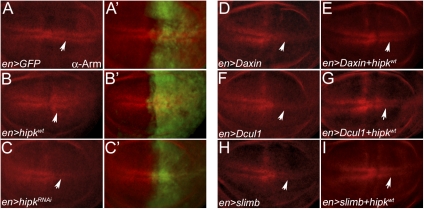Fig. 1.
Hipk stabilizes Arm by inhibiting the function of members of the destruction complex and/or ubiquitination machinery. In wild-type w1118 wing discs, Arm is stabilized in two stripes of cells adjacent to the D/V boundary (A and A’). Overexpression of hipk using en-Gal4 (expression domain seen by GFP stain in A’–C’) enhances the levels of stabilized of Arm in the posterior compartment of the wing disc (B and B’), whereas the depletion of hipk through RNAi decreases the amount of stabilized Arm and constricts its domain at the D/V boundary in that compartment (C and C’). Using en-Gal4 to overexpress Daxin (D), the scaffold for the destruction complex, results in loss of stabilized Arm at the D/V boundary in the posterior compartment. This effect is rescued by the coexpression of hipk (E). Similarly, stabilized Arm is lost at the D/V boundary in the posterior compartment as a result of overexpression of members of the ubiquitination machinery, Dcul1 (F) and slimb (H). As in the case of Daxin, this effect is suppressed and the levels of stabilized Arm are rescued by the coexpression of hipk (G and I). Arrows are shown to indicate the position of the two stripes of stabilized Arm, which are affected in the experimental genotypes.

